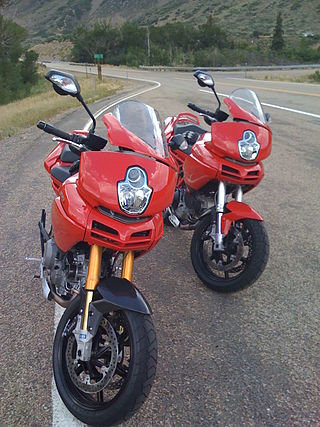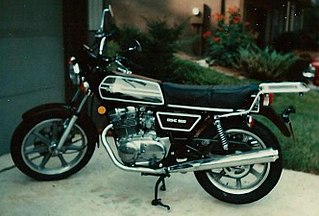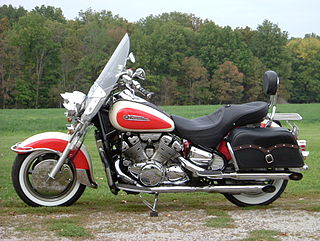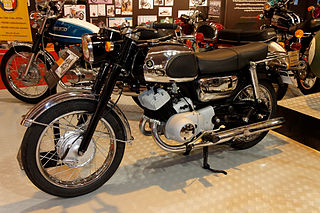
The Megola was a German motorcycle produced between 1921 and 1925 in Munich. Like Bimota, the name is a portmanteau derived from the names of its designers Meixner, Gockerell, and Landgraf.

Junak is a brand of Polish motorcycles, the only four-stroke models produced in Poland between World War II and the Revolutions of 1989. The name literally means "brave young man". Produced by Szczecińska Fabryka Motocykli (SFM) in three variants: M07, M10 and B20.

First introduced in 2003, the Ducati Multistrada is a series of V-twin and V4 touring focused motorcycles. Essentially a hybrid of a supermoto and a sport-tourer, the Multistrada competes in the market with other dual-sport motorcycles such as the BMW GS. The first iteration of the Multistrada was, like the Yamaha TDM850, neither intended nor suitable for off-road use. Subsequent models were more suited to a proper dual-sport role.

The Suzuki GSX-R750 is a sports motorcycle made by Suzuki since 1984. It was introduced at the Cologne Motorcycle Show in October 1984 as a motorcycle of the GSX-R series for the 1985 model year.

The R60 and R60/2 are 600 cc boxer-twin that were manufactured from 1956 to 1969 in Munich, Germany, by BMW.
The following outline is provided as an overview of and topical guide to automobiles:
Motorcycle components and systems for a motorcycle are engineered, manufactured, and assembled in order to produce motorcycle models with the desired performance, aesthetics, and cost. The key components of modern motorcycles are presented below.

The Yamaha FZ750 is a sports motorcycle produced by Yamaha Motor Corporation between 1985 and 1991. The FZ750 is notable for several reasons, perhaps the most radical being the 5-valve cylinder head with a radial arrangement. This became something of a Yamaha trademark. The FZ750 would be the first bike in the Genesis design concept.
BMW Motorrad is the motorcycle brand and division of German automotive manufacturer, BMW. It has produced motorcycles since 1923, and achieved record sales for the fifth year in succession in 2015. With a total of 136,963 vehicles sold in 2015, BMW registered a growth of 10.9% in sales in comparison with 2014. In May 2011, the 2,000,000th motorcycle produced by BMW Motorrad was an R1200GS.

The Vincent Rapide is a line of standard motorcycles designed and built by the Vincent HRD motorcycle company at their works in Great North Road, Stevenage, Hertfordshire, England. The model debuted in 1936 and was built until 1939. Production resumed in 1946 and ended in 1955. Four major versions were built, labelled Series A through D.

The Yamaha TX500 is a two-cylinder standard motorcycle built by Yamaha and sold in 1973 and 1974. Early models closely resembled the Triumph Bonneville in style. In 1975 the bike was renamed XS500 and then continued to be updated until 1978 when sales ended in the USA. In Europe, the model was available through 1980.

In 1996 Yamaha introduced the Royal Star motorcycle. This motorcycle uses the basic power package from the Yamaha Venture Royale.
The James Comet was a 98 cubic centimeter (cc), two-stroke, motorcycle manufactured by the James Cycle Co. and announced on 21 October 1948. A post-World War II design, the Comet went into production in late 1948.

The Ducati ST series is a set of Italian sport touring motorcycles manufactured by Ducati from 1997 through 2007. In order of release, the series comprised five distinct models: the ST2, ST4, ST4S, ST3, and ST3S. Intended to compete with other sport-tourers such as the Honda VFR, the ST Ducatis had a full fairing, a large dual seat and a relaxed riding position for both rider and pillion. The ST bikes had a centre-stand, and could be fitted with optional matching luggage.

The Kawasaki A1 Samurai is a 250 cc (15 cu in) standard class Kawasaki motorcycle which was sold from 1967 through 1971.
The Audi R8 LMS Cup was a one-make sports car racing series by Audi based in Asia. Audi R8 LMS Cup cars were based on the Audi R8 LMS (GT3).

The G450X is an Enduro-class motorcycle that was produced by BMW Motorrad between 2008 and 2011.

The Suzuki T10 is a 246 cc (15.0 cu in), two-stroke, twin-cylinder motorcycle produced by the Japanese Suzuki company between 1962 and 1967. The model was based on the earlier Colleda TT and had an improved frame. It was marketed as the El Camino in the US and was Suzuki's first twin the be sold in America.
Suzuki T125 was the designation given to two different models of 124 cc (7.6 cu in), two-stroke, twin-cylinder motorcycles produced by the Japanese Suzuki company between 1967 and 1971. The first shared the layout and styling of the 250 cc T20 and was produced in 1967 and '68. The second was more a more radical design that shared many parts with the smaller T90 and was produced from 1969 - '71.

Clúa was a Spanish motorcycle and automobile brand by Construcciones Metálicas Clúa from 1949 to 1962. The company was owned and founded by Joan Clúa i Maluquer. Its headquarters was located at 6 Avenida de Pau Casals, Barcelona, Spain, at the time called Avenida General Goded, and the assembly line was located at Carrer d'Espronceda.